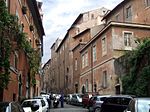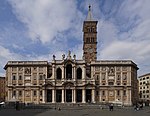San Martino ai Monti
4th-century churchesBasilica churches in RomeChurches of Rome (rione Monti)Titular churches

San Martino ai Monti, officially known as Santi Silvestro e Martino ai Monti ("Saints Sylvester & Martin in the Mountains"), is a minor basilica in Rome, Italy, in the Rione Monti neighbourhood. It is located near the edge of the Parco del Colle Oppio, near the corner of Via Equizia and Viale del Monte Oppio, about five to six blocks south of Santa Maria Maggiore. The current Cardinal Priest with title to the basilica is Kazimierz Nycz, the Archbishop of Warsaw. Among the previous titulars are Alfonso de la Cueva, Joseph Mary Tomasi, C.R., Pope Pius XI, Alfredo Ildefonso Schuster, O.S.B., and Gianbattista Montini, later Pope Paul VI.
Excerpt from the Wikipedia article San Martino ai Monti (License: CC BY-SA 3.0, Authors, Images).San Martino ai Monti
Viale del Monte Oppio, Rome Municipio Roma I
Geographical coordinates (GPS) Address Website External links Nearby Places Show on map
Geographical coordinates (GPS)
| Latitude | Longitude |
|---|---|
| N 41.89444 ° | E 12.49833 ° |
Address
Basilica di San Martino ai Monti (Santi Silvestro e Martino ai Monti)
Viale del Monte Oppio 28
00185 Rome, Municipio Roma I
Lazio, Italy
Open on Google Maps











